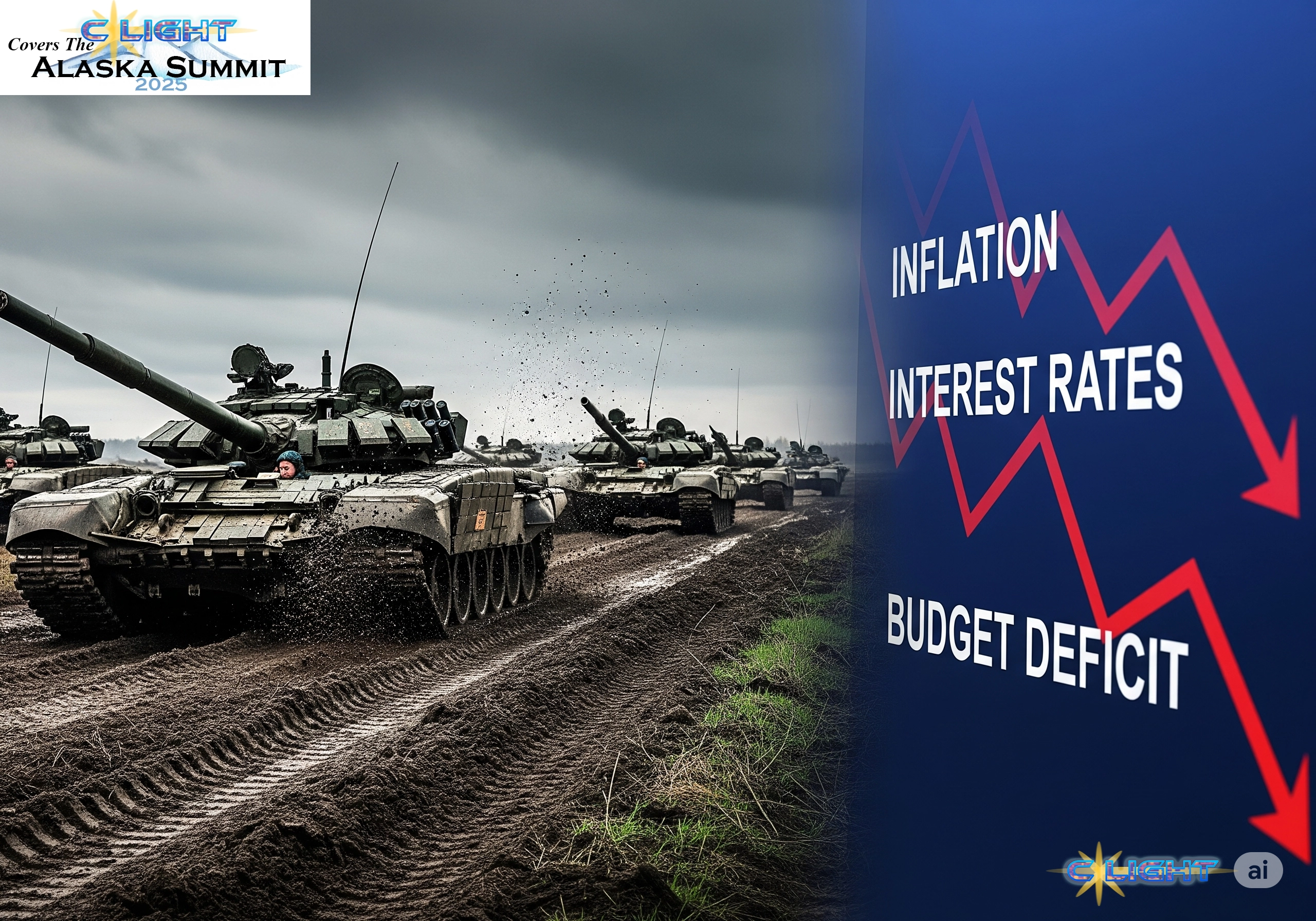5 minutes read time.
As Vladimir Putin sits across from the Felonious Punk in Anchorage, he does so from a position of undeniable battlefield momentum. His military, once seen as a lumbering and incompetent force in the disastrous early days of the 2022 invasion, has been brutally and effectively re-engineered into a grinding war machine. Through a combination of tactical evolution, a supercharged domestic arms industry, and a recruitment strategy fueled by staggering financial incentives, Russia is prosecuting a war of attrition that it believes it can win. Yet, beneath this veneer of military might lies a foundation of profound economic fragility. The very system Putin has built to fund his war—a “shadow war chest” built on a mountain of high-risk debt—is now showing deep and alarming cracks, creating a stark contradiction that defines Russia’s true leverage at the negotiating table.
On the surface, Russia’s military resurgence is a terrifying success story. After the decimation of its professional army, the Kremlin pivoted to a strategy that transformed the economics of military service. As detailed in a revelatory New York Times report, the financial incentives are staggering: a typical Russian soldier now earns around $2,450 a month, nearly triple the national average, supplemented by an average sign-up bonus of $30,000. Life-altering injuries come with massive payouts, and even destroying enemy equipment carries a specific cash bonus. This strategy has allowed Russia to recruit roughly 1,000 soldiers a day without resorting to a politically toxic general draft, replacing its skilled but depleted early forces with a steady stream of volunteers drawn from the margins of Russian society.
This recruitment is backed by an industrial base that has been put on a full war footing. Drawing on its vast Soviet-era network of factories and assistance from partners like Iran and North Korea, Russia has turbo-charged the production of everything from artillery shells to advanced drones. The Yelabuga plant in Tatarstan, for example, now operates 24/7, producing an estimated 80 Geran-2 attack drones per day—a Russian version of the Iranian Shahed. This industrial might allows Russia to launch relentless nightly bombing campaigns, firing an average of 200 drones at Ukraine in a single 24-hour period. Concurrently, Russia’s battlefield tactics have evolved from the disastrous armored columns of 2022 to a slow, grinding strategy of encirclement, using waves of drones to destroy supply lines before infantry, often on foot or motorbike, slowly seize territory.

This is the “iron fist” that Putin presents to the world—a confident, resilient, and adaptable military capable of sustaining a long war. But this entire enterprise is being paid for by a precarious economic house of cards, as a months-long Bloomberg News investigation has revealed. To fund the war without immediately cratering the official state budget, Putin effectively conscripted the nation’s banking sector. State-controlled banks were compelled to issue massive, low-interest “preferential” loans to defense contractors, regardless of their creditworthiness. This created a parallel fiscal channel, turning the banking system into a shadow war chest built on an ever-growing mountain of debt. Craig Kennedy at Harvard’s Davis Center estimates that Russian corporate debt may have surged by as much as 71% since 2022, creating a “black box of poorly managed risk.”
For a time, the juggling act worked, propped up by high oil prices. But the facade is now crumbling. The massive, debt-fueled spending ignited rampant inflation, with consumer prices rising over 10% by mid-2025. This forced the central bank governor, Elvira Nabiullina, to hike the key interest rate to a staggering 21%. This move, necessary to fight inflation, created a death spiral for the banks: they were now paying high interest rates on their own borrowing while being stuck holding a massive portfolio of fixed, low-rate war loans. The economic strain has become so acute that it has spilled into public view. At a recent forum, top Russian economic officials openly fretted about the situation. Economy Minister Maxim Reshetnikov warned Russia was “on the verge of slipping into a recession,” while Sberbank CEO Herman Gref described the economy as facing a “perfect storm.”

This is the reality of Russia’s “clay feet.” The budget deficit has widened to its largest in three decades, oil revenues have slumped, and the national rainy-day fund is being rapidly depleted to prop up the very banks financing the war. Senior banking officials are now privately warning of a credible risk of a debt crisis within the next year and have discussed the need for bailouts. The dilemma for Putin is stark and unforgiving: if he continues the war, the economic problems will likely worsen, risking a systemic banking collapse. If he agrees to a lasting peace, the sudden halt in military spending could trigger a cascade of defaults among the heavily indebted contractors, potentially causing the very crisis he sought to avoid.
This is the crucial context for the Alaskan summit. While Putin projects an image of battlefield confidence, his presence in Anchorage is a tacit admission of the severe economic pressure he faces, a pressure the Felonious Punk seems to sense. As Richard Portes, a professor at London Business School, told Newsweek, “The Russian economy is in deep trouble… Putin is playing a weak hand.” The summit, therefore, is not merely a negotiation about territory; it is a clash between two fundamentally different forms of power. It pits Russia’s immediate, tangible military leverage against the slow, grinding, but potentially catastrophic power of economic reality. The ultimate outcome will reveal which of these forces Vladimir Putin fears more.
Discover more from Clight Morning Analysis
Subscribe to get the latest posts sent to your email.










